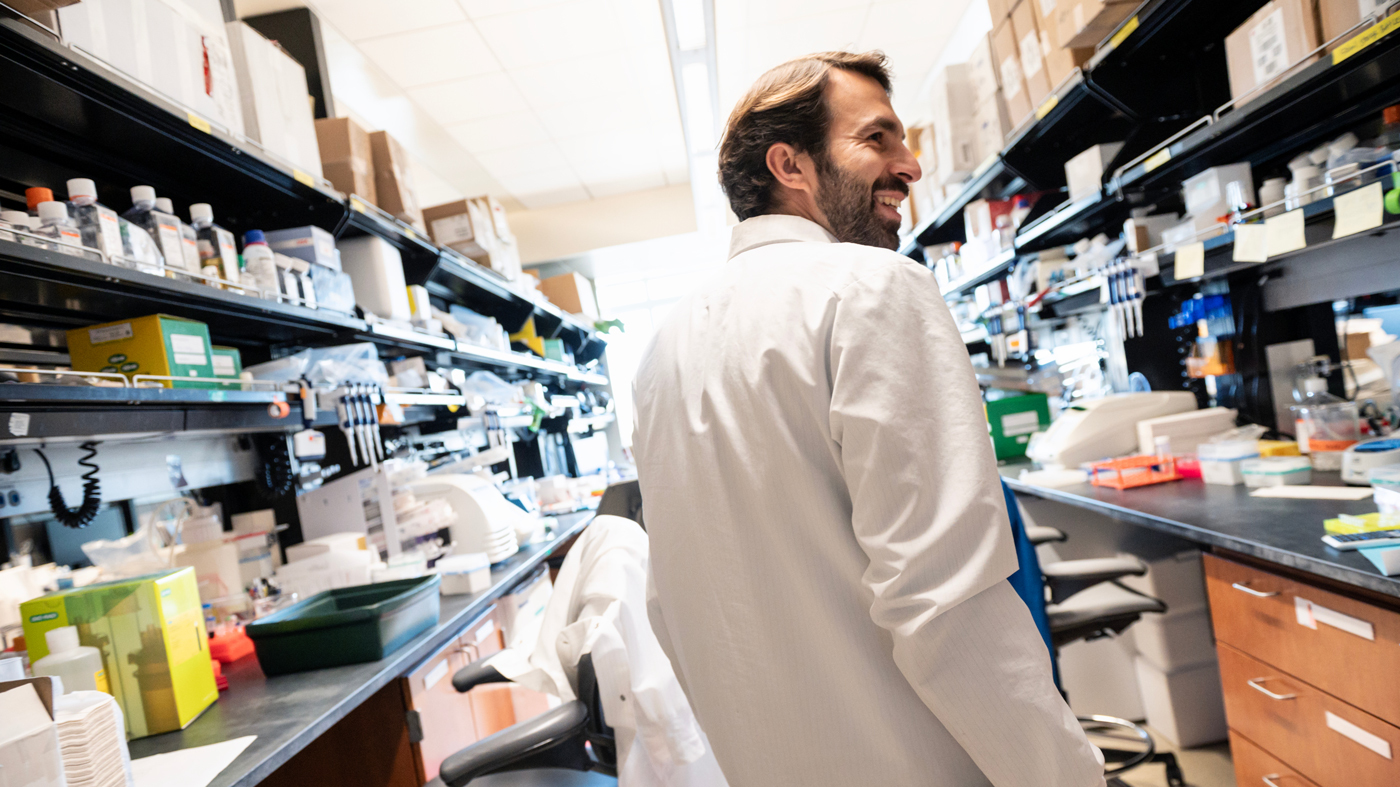Gladstone NOW: The Campaign Join Us on the Journey✕

A team of scientists—including Murad Mamedov, seen here—explains how understudied cells in the immune system, called gamma delta T cells, can target cancer cells for destruction.
Gamma delta T cells, a special type of cell in the immune system, are incredibly effective at recognizing and killing cancer cells. Cancer patients with higher levels of these T cells in their tumors tend to fare better than those with lower levels. But scientists have struggled to understand exactly how gamma delta T cells can recognize cancerous cells, and how new cancer therapies may be able to take advantage of these powerful immune cells.
Now, researchers at Gladstone Institutes and UC San Francisco have pinpointed conditions that enable gamma delta T cells to identify cancer cells. The work was published in the journal Nature.
“We used the power of CRISPR genome editing to get fundamental insights into what can make cancer cells recognizable to gamma delta T cells so they can be targeted for elimination,” says Alex Marson, MD, PhD, director of the Gladstone-UCSF Institute of Genomic Immunology and senior author of the new study. “Our work opens the door to thinking about how this pathway could eventually be targeted in future immunotherapies.”

Marson and his colleagues uncovered how gamma T cells can recognize, and kill, cancer cells—insights that could be used in future immunotherapies.
“This study gives us crucial insight into factors operating inside cancer cells that can trigger recognition and destruction by gamma delta T cells, one of the more potent assassins of the immune system,” adds Erin J. Adams, PhD, professor of biochemistry and molecular biophysics at the University of Chicago, who collaborated with Marson on this study.
An Understudied Cell Type
T cells are a type of white blood cell responsible for recognizing trouble in the body—from invading viruses or bacteria to cancer cells with genetic mutations. There are billions of T cells patrolling your body, and they have a protein on their surface called a T cell receptor, which recognizes molecules on the target cells. Many experimental cancer treatments being studied today try to re-engineer T cell receptors so that T cells can better target tumors.
Previous studies have shown that a subset of T cells, known as gamma delta T cells, can be especially good at spotting cancer cells across various sites in the body. But, at a molecular level, the conditions needed for gamma delta T cells to identify and clear cancer cells were unclear, making it difficult for scientists to envision ways to boost this process.
“We knew that gamma delta T cells recognize their target cells in a very different way from conventional T cells, but the field has had some trouble figuring out exactly how the gamma delta T cells were recognizing the cancer cells,” says Murad Mamedov, PhD, postdoctoral scholar at Gladstone and first author of the study.

Mamedov and his fellow researchers used CRISPR to identify the gene disruptions that help gamma delta T cells recognize and kill cancer cells.
Mamedov, Marson, and their collaborators used CRISPR technology to disrupt thousands of genes in lymphoma cells and systematically test which gene disruptions affect whether or not the gamma delta T cells are killing cancer cells. They confirmed that the gamma delta T cells were recognizing a complex of molecules called butyrophilins, which were previously shown to be targeted by gamma delta T cells. But these molecules are found on the surface of many human cells—both healthy and diseased.
“In this case, it turned out that just knowing what gamma delta T cells recognize was not sufficient,” says Mamedov. “We needed to know how the butyrophilins are regulated and what makes them different in some cancer cells.”
To that end, the team confirmed another previously shown fact that hyperactive cholesterol production—a common feature of many rapidly dividing cancer cells—led to activation of the butyrophilin complex, making it accessible to the gamma delta T cells.
A Signal for Stress
When they looked more closely at the results from their CRISPR screen, the researchers found that gene deletions that caused cellular stress and depleted energy production in cancer cells made these cells more likely to be killed by gamma delta T cells, and also increased the amount of butyrophilin molecules at the surface of cancer cells.
Using this insight, they showed that when tumor cells from cancer patients are treated with a drug that mimics a cell’s stress response, these tumor cells are more easily recognized by gamma delta T cells because of their increased butyrophilins and, as a result, are killed more efficiently.
“In healthy cells, butyrophilin is invisible to gamma delta T cells, so that T cells don’t start killing them,” explains Mamedov. “But when stress pathways are increased in cancer and the butyrophilins are activated, these molecules become more abundant and act as a target for gamma delta T cells.”

The study by Mamedov (left), in conversation here with intern Kirsten Takeshima (right), and his collaborators moves us closer to designing drugs that could boost gamma delta T cells' ability to clear cancer.
While the new results primarily shed light on the basic biology of how gamma delta T cells work and how they may have evolved, they also suggest that therapies manipulating the abundance of butyrophilin on the surface of patients’ cancer cells could make gamma delta T cells more effective cancer fighters.
“Much work lies ahead to design drugs that can boost cancer clearance by gamma delta T cells, but the findings of this team led by Murad move us a step closer by giving us fundamental insights into how gamma delta T cells recognize cancer targets,” says Marson.
“This amazing collaboration, which connected basic and clinical translational researchers, will allow scientists and physicians to not only better select patients for immune therapies using g9d2T cell receptors, but also to design novel compounds to enhance activity of these receptors,” says Jürgen Kuball, MD, PhD, one of the authors of the study, as well as professor of hematology and chair of the Department of Hematology at University Medical Center Utrecht.
For Media
Julie Langelier
Associate Director, Communications
415.734.5000
Email
About the Study
The paper, “CRISPR screens decode cancer cell pathways that trigger ɣδ (gamma delta) T cell detection,” was published online by the journal Nature on August 30, 2023. Other authors are Shane Vedova, Jacob W. Freimer, Maya M. Arce, Mineto Ota, Peixin Amy Chen, Vinh Q. Nguyen, Kirsten A. Takeshima, and Kristina Hanspers of Gladstone; Avinash Das Sahu of University of New Mexico; Amrita Ramesh of University of Chicago; Angelo D. Meringa and Zsolt Sebestyen of University Medical Center Utrecht; Anne C. Rios of Princess Máxima Center; and Jonathan K. Pritchard of Stanford University.
The work was supported by the Cancer Research Institute, the Human Immunome Project, the Michelson Medical Research Foundation, the National Institutes of Health (R01HG008140, T32GM007281, 5R25HL121037, R01AI155984), the National Science Foundation (2038436), the Astellas Foundation for Research on Metabolic Disorder, the Chugai Foundation for Innovative Drug Discovery Science, the Mochida Memorial Foundation for Medicine and Pharmaceutical Research, Gladstone’s PUMAS program, Oncode-PACT, the Dutch Cancer Society (KWF 11393, 12586, 13043), The Cancer League, the Innovative Genomics Institute, the Simons Foundation, and the Parker Institute for Cancer Immunotherapy.
About Gladstone Institutes
Gladstone Institutes is an independent, nonprofit life science research organization that uses visionary science and technology to overcome disease. Established in 1979, it is located in the epicenter of biomedical and technological innovation, in the Mission Bay neighborhood of San Francisco. Gladstone has created a research model that disrupts how science is done, funds big ideas, and attracts the brightest minds.
About UCSF
The University of California, San Francisco (UCSF) is exclusively focused on the health sciences and is dedicated to promoting health worldwide through advanced biomedical research, graduate-level education in the life sciences and health professions, and excellence in patient care. UCSF Health, which serves as UCSF’s primary academic medical center, includes top-ranked specialty hospitals and other clinical programs, and has affiliations throughout the Bay Area. Learn more at ucsf.edu or see our Fact Sheet.
Genomic Maps Untangle the Complex Roots of Disease
Genomic Maps Untangle the Complex Roots of Disease
Findings of the new study in Nature could streamline scientific discovery and accelerate drug development.
News Release Research (Publication) Marson Lab GenomicsSix Gladstone Scientists Named Among World’s Most Highly Cited Researchers
Six Gladstone Scientists Named Among World’s Most Highly Cited Researchers
The featured scientists include global leaders in gene editing, data science, and immunology.
Awards News Release Corces Lab Doudna Lab Marson Lab Pollard Lab Ye LabThe Genome Editing Playbook Is Different in Neurons
The Genome Editing Playbook Is Different in Neurons
The striking findings of a new study could influence how gene therapies are designed for many genetic diseases.
News Release Research (Publication) Neurological Disease Conklin Lab Doudna Lab CRISPR/Gene Editing



